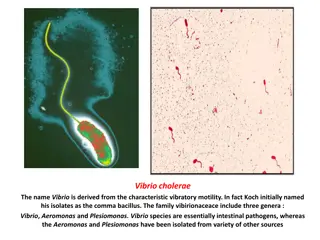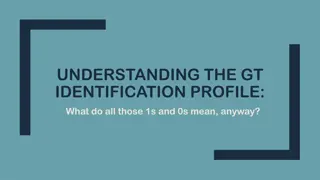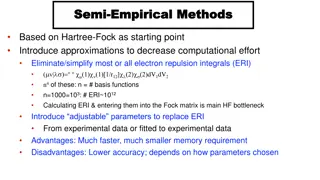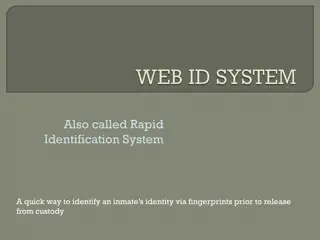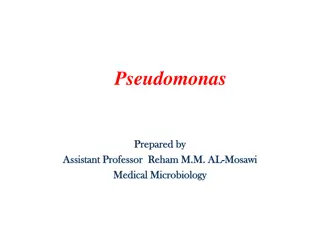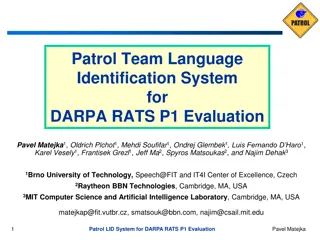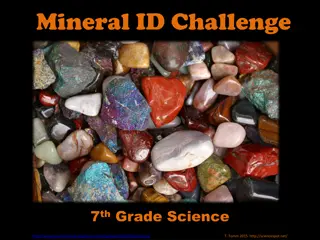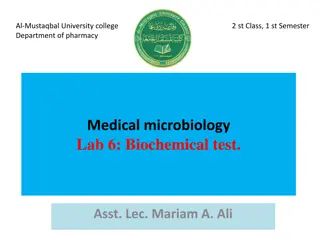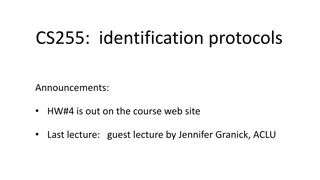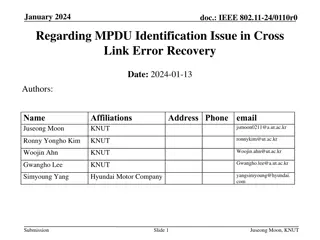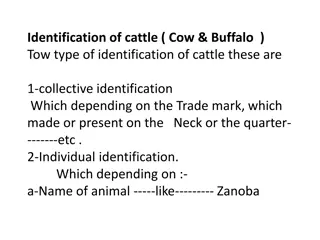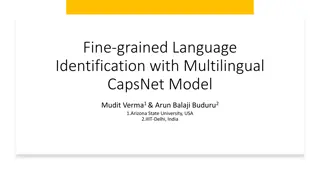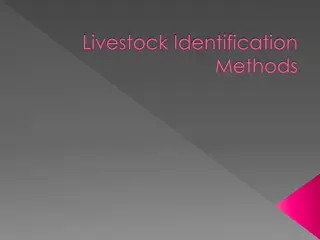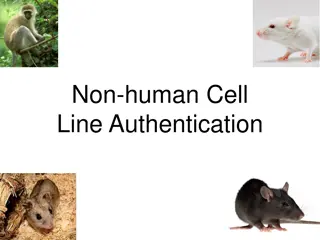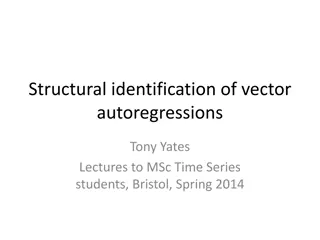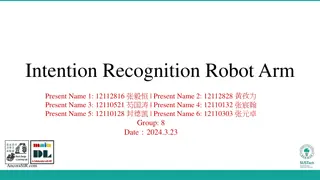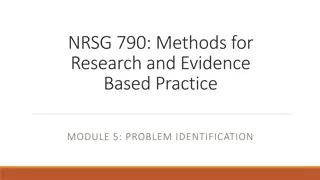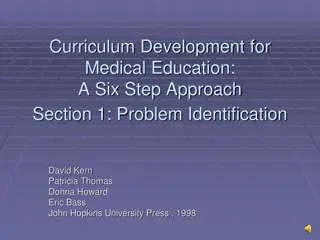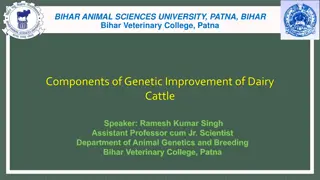Extension Teaching Methods
Extension teaching methods play a crucial role in facilitating communication and knowledge transfer between rural communities and extension workers. These methods aim to engage, stimulate, and guide learners through the process of acquiring new skills and knowledge. Centurion University in India emp
4 views • 8 slides
Fish Breeding and Spawn Management Techniques by Dr. S.P. Sahu
Dr. S.P. Sahu, an Assistant Professor at Bihar Veterinary College in Patna, provides valuable insights into fish breeding and spawn management. The content covers fish seed collection, procurement methods, fry identification, and confined water breeding techniques. Detailed information on Indian maj
2 views • 26 slides
Overview of Vibrio cholerae: Characteristics and Identification
Vibrio cholerae is a gram-negative, curved rod bacterium known for causing cholera. Its distinctive features include polar flagellum motility, oxidase-positive nature, and resistance to inhibitory substances. Various culture media are used for its isolation and growth, such as transport, routine, an
0 views • 8 slides
Decoding the GT Identification Process: Understanding the Numbers
Exploring the intricate world of Gifted and Talented (GT) identification, this insightful guide delves into the significance of 1s and 0s, the criteria for GT scoring, percentile ranks, and the importance of Ability Profiles. Discover the nuances of GT testing, identification, stanines, and more to
1 views • 19 slides
Identification and Assay of Ammonium Chloride: Experiment Insights
Explore the identification and assay process of Ammonium Chloride (NH4Cl), a weak inorganic acid commonly used in various applications. Discover its chemical properties, synthesis, reactivity, identification tests, and details of a titration process using NaOH and phenolphthalein as indicators.
0 views • 16 slides
Overview of Semi-Empirical Methods Based on Hartree-Fock
Semi-empirical methods derived from Hartree-Fock theory aim to reduce computational effort by approximating or eliminating electron repulsion integrals. Strategies include introducing adjustable parameters to replace ERI calculations and utilizing zero differential overlap methods like CNDO, INDO, N
1 views • 11 slides
Understanding Talent Identification and Selection in Sports
Talent identification in sports involves recognizing and developing the total potential of athletes in various aspects, aiming for long-term growth rather than focusing solely on immediate performance. It focuses on understanding real potential and systematically developing it over time through qual
1 views • 9 slides
Rapid Identification System for Inmate Release
The Rapid Identification System, also called Rapid ID System, provides a quick way to verify an inmate's identity using fingerprints before release from custody. It allows law enforcement agencies, including IPD users under SDSheriff, to log in and access the system. By searching the San Diego AFIS
3 views • 8 slides
Efficient Identification of Memory Chip Errors with On-Die ECC
State-of-the-art memory error mitigations face challenges when dealing with on-die Error-Correcting Codes (ECC). "HARP" introduces a Hybrid Active-Reactive Profiling method to address these challenges by analytically studying the effects of on-die ECC and identifying key issues. Through hybrid profi
1 views • 4 slides
Overview of Pseudomonas aeruginosa: Morphology, Identification, and Lab Diagnosis
Pseudomonas aeruginosa is a gram-negative, motile bacterium commonly found in soil, water, plants, and animals. It is a major pathogen known for causing infections in individuals with weakened immune systems. This article delves into the morphology, identification techniques, and lab diagnosis metho
0 views • 7 slides
Understanding Microbiology Testing Methods and Results
Explore the various methods of microbiology testing, learn to interpret microbiological test results, and understand antibiotic susceptibility testing. Discover details on bacterial, viral, and parasitic infections through laboratory reports and supporting results like WBC counts and pathogen identi
0 views • 29 slides
Understanding Contraception: Methods, Importance, and Considerations
Contraception refers to methods used to prevent unwanted pregnancies, regulate pregnancy timing, and spacing between pregnancies. It is essential for women's reproductive health and can include barrier methods, hormonal methods, emergency contraception, and intrauterine devices. These methods are sa
3 views • 28 slides
Postmortem Fingerprinting Techniques in Deceased Individuals
Postmortem fingerprinting is essential in cases where identification is challenging due to factors like mass disasters or decomposition. This process involves preliminary preparations, methods of recording fingerprints, and specific techniques for cadavers in different states, such as recent death o
0 views • 21 slides
Understanding LRIT System for Ship Identification and Tracking
LRIT (Long Range Identification and Tracking) system enables global identification and tracking of ships for security purposes. Ships equipped with LRIT system can autonomously transmit ship data to authorized authorities. LRIT system is mandatory for certain types of vessels as per SOLAS convention
0 views • 12 slides
Understanding Methods of Social Work
Methods of social work encompass various approaches aimed at enhancing social functioning and addressing problems in individuals and communities. These methods are categorized into primary and secondary methods, each serving different purposes in the field. Primary methods involve direct interaction
0 views • 20 slides
Language Identification System for DARPA RATS Program Evaluation
The Patrol Team Language Identification System was developed for DARPA RATS Program to create algorithms and software for speech tasks in noisy environments. The system involved analyzing datasets, implementing subsystems for language identification, and evaluating performance across different langu
0 views • 19 slides
Speaker Identification in Monetary Policy Meetings at Sveriges Riksbank
This study focuses on speaker identification in monetary policy meetings at Sveriges Riksbank, using a supervised approach to predict individual board members. By analyzing the anonymized minutes of meetings before June 2007 and known deliberations thereafter, the study aims to understand how increa
0 views • 18 slides
Understanding Moving Averages and Exponential Smoothing Methods
Forecasting methods like moving averages and exponential smoothing are essential for analyzing time series data. Averaging methods involve equally weighted observations, while exponential smoothing methods assign unequal weights that decay exponentially. Both methods can be useful for forecasting in
0 views • 18 slides
Mineral Identification Challenge for 7th Grade Science Students
Engage in a Mineral Identification Challenge where 7th-grade students will explore various minerals using color, streak, luster, transparency, texture, composition, density, crystal shape, cleavage/fracture, hardness, and special properties. Students will rotate through different stations, perform t
0 views • 11 slides
Microbiology Biochemical Tests for Bacterial Identification
Learn about important biochemical tests used in medical microbiology, including the Coagulase test for Staphylococcus aureus, the Catalase test for enzyme detection, and the Oxidase test for electron transport chain identification. Detailed methods and result interpretations are provided for each te
0 views • 17 slides
Livestock Data Management and Recording Guidelines
This documentation outlines the correct procedures for submitting livestock data, including details on birth notifications, calving information, AI processes, calf identification, and more. Topics covered include birth dates, twin identification, AI horn codes, dam and sire identification, calving e
0 views • 11 slides
Overview of Identification Protocols in CS255 by Dan Boneh
The lecture in CS255 covers various topics related to identification protocols, including signatures from trapdoor functions, certificates, revocation methods, certificate issuance problems, defense mechanisms like certificate transparency (CT), and moving on to protocols. The talk also explores the
0 views • 43 slides
Error Recovery Methods for MPDU Identification in IEEE 802.11-24
Fast error recovery methods for identifying errored MPDUs in IEEE 802.11-24 are proposed in this document. The issue of MPDU identification in cross-link error recovery is addressed, presenting two options: information-based recovery and time-based indication. These methods aim to reduce delay and i
0 views • 8 slides
Cattle Identification Methods and Characteristics Explained
Explore different methods of identifying cattle including collective and individual methods such as branding, tattooing, and tagging. Learn about cattle species, breeds, colors, and aging factors like dentition and parturition. Discover the main color variations in cattle such as yellow, red, black,
0 views • 36 slides
Understanding Helicobacter pylori: Morphology, Pathogenesis, and Identification
In this detailed lecture, Assistant Professor Dr. Dalya Basil discusses the characteristics, identification methods, growth characteristics, and pathogenesis of Helicobacter pylori. This spiral-shaped, gram-negative rod bacterium is associated with various gastric conditions, including gastritis, ul
1 views • 23 slides
Fine-Grained Language Identification Using Multilingual CapsNet Model
This study explores fine-grained language identification through a multilingual CapsNet model, addressing challenges such as short audio snippets, multiple languages, noise, limited training data, and non-class identification. The dataset includes various languages like Arabic, Bengali, Chinese, Eng
0 views • 36 slides
Livestock Identification Methods: Exploring Different Techniques
Explore the importance of livestock identification, methods used, and their significance in various situations. Understand why animals need to be identified, from proof of ownership to disease eradication. Learn about types of identification like branding, ear notching, tattooing, and more, each wit
0 views • 16 slides
Methods of Non-Human Cell Line Authentication and Identification
Techniques such as chromosomal karyotyping, DNA barcoding, and STR genotyping are used for authenticating and identifying non-human cell lines to ensure accurate research outcomes. Species-level identification, karyotyping, and commercial services for mouse and rat cell lines are discussed, highligh
0 views • 16 slides
Understanding Remote Identification of Unmanned Aircraft: Compliance Methods
The Final Rule on Remote Identification of Unmanned Aircraft introduces compliance methods for the model aircraft community to fly safely in national airspace. Explore the three ways to comply, including Standard Remote ID, Broadcast Modules, and FAA Recognized Identification Areas. Learn about regi
0 views • 11 slides
Understanding Structural Identification in Vector Autoregressions
Explore the algebra of identification problems in VARs, including Cholesky factorization, timing restrictions, long-run impact restrictions, sign restrictions, and identification through heteroskedasticity. Discover why structural identification is crucial for policy design, economic modeling, and u
0 views • 63 slides
Approaches to Secure Identification in Communication Networks
This content discusses various methods and protocols for secure identification and authentication in communication networks. It covers topics such as using passwords, biometrics, cryptographic protocols, and one-time password systems. Different approaches, their reliability, security levels, and cos
0 views • 11 slides
Assistive System Design for Disabilities with Multi-Recognition Integration
Our project aims to create an assistive system for individuals with disabilities by combining IMU action recognition, speech recognition, and image recognition to understand intentions and perform corresponding actions. We use deep learning for intent recognition, gesture identification, and object
0 views • 14 slides
Understanding Minerals: Properties and Identification
Minerals are naturally occurring solid inorganic substances with definite compositions and structures. They are classified based on physical and chemical properties. This content discusses the definition of minerals, the conditions that classify gold as a mineral, distinguishing mineral characterist
0 views • 29 slides
Research Methods and Evidence-Based Practice for Problem Identification
This module focuses on problem identification in research and evidence-based practice, emphasizing the importance of identifying the problem before seeking a solution. It covers components of the PICO framework, constructs well-built clinical questions, and provides examples related to hospitalized
0 views • 6 slides
Performance Studies of dRICH Detector at ePIC Experiment
The Electron-Ion Collider ePIC experiment focuses on the performance studies of the dRICH detector for particle identification crucial in various physics channels. The detector features aerogel optimization, SiPM sensors, and test-beam analyses. Key capabilities include different techniques for part
0 views • 28 slides
Fundamentals of Marketing: Product Identification and Branding Insights
Explore the essential concepts of marketing including the marketing mix, product identification methodology, and the significance of branding in differentiating products. Learn about the 4Ps of marketing mix - Product, Price, Place, and Promotion, and how branding plays a crucial role in establishin
0 views • 15 slides
Six Step Approach to Problem Identification in Medical Curriculum Development
In this comprehensive guide on curriculum development for medical education, the focus is on identifying and addressing key problems in the curriculum design. The six-step approach outlined covers problem identification, needs assessment, goal setting, educational strategies, implementation, and eva
0 views • 12 slides
Genetic Improvement of Dairy Cattle: Key Components and Strategies
Understanding the genetic improvement of dairy cattle is crucial for enhancing milk production. This article explores the key components involved, such as unique identification systems, parentage recording, milk yield monitoring, artificial insemination, and genetic evaluation methods. Achieving exc
0 views • 11 slides
Importance of Verification for Patient Identification & Blood Product Labeling in Medical Procedures
This educational program emphasizes the crucial role of verifying patient identification and blood product labeling in medical settings. It covers the significance of accurate verification, policy expectations, and the process for ensuring patient safety during blood product administration. The prog
1 views • 30 slides
Tracking and Identifying People with Millimeter Wave Radar
This study presents a human tracking and identification system using mmWave radar technology, offering high precision and the ability to conceal behind materials. The system achieved a median tracking accuracy of 0.16m and an identification accuracy of 89% for 12 individuals. Unlike traditional meth
0 views • 12 slides


